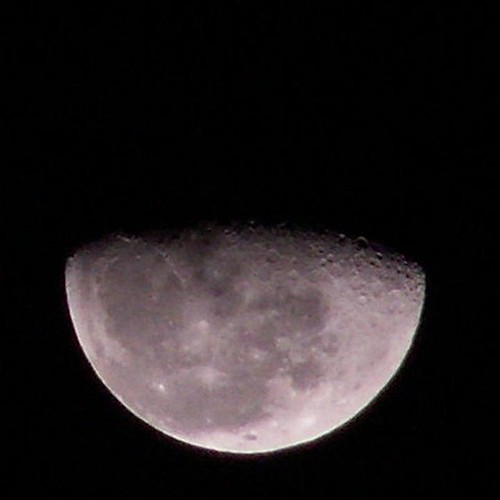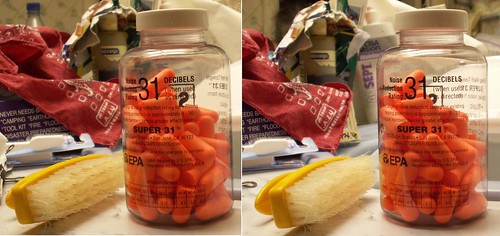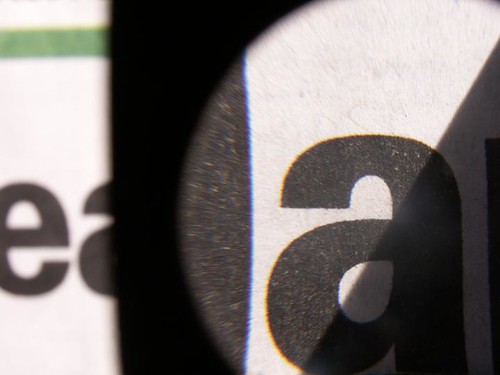Questions of Perception

Taken at 1:27 AM (EST). The Moon is 64 percent of full.
Hours before the Moon rose last night, Mary and I had returned to the painted brick column where 24 hours earlier she had pointed up to a spot below the overhang. The creature there hadn't moved in all that time and I wondered if it was dead. As I snapped more shots to compare with the first set, to see if the moth had moved any, a man from the local hospice center stepped outside and asked what we were doing....
"I think it's a Tersa Sphinx Moth, but I'm not sure," I said. It had the Tersa's wing shape and size. The horn at its rear was similar to the horn I'd seen on the caterpillar of the species, which I'd photographed on our kitchen screen not long ago.
And there my confusion lay. If it was a Tersa Sphinx it seemed half-moth, half-caterpillar. Was I looking at something caught in mid-metamorphosis? Had it died trying to emerge from its coccoon?
According to Bugguide.Net, Tersa Sphinx caterpillars "usually pupate in soil, though some form loose coccoons among leaf litter." If this one was pupating it was very much in the wrong place.

This morning I got the ID and the good news. Bugguide.Net's Patrick Coin identified this as a male Mournful Sphinx Moth (Enyo lugubris). He wrote, "I've seen them sit in one place for a long time in cool weather--they do appear to be dead, but I'm sure your moth is very much alive."
That made me grin. Actually, it made me whoop.
According to the site, the Mournful Sphinx ranges from southern North America into the neotropics and its habitat is "presumably" forest edges. It spends its season all year in the tropics, August-November northward. "Larvae feed on grape family plants, Vitus, Ampelopsis, and Cissus species (Moths of North America). Pupation occurs in a shallow burrow in the soil. Adults fly during the day, and apparently at night, because they are attracted to lights. Flies in cold weather (pers. obs. P. Coin). Seems to be found in the coastal plain, and in particular, the outer coastal plain and barrier islands."
According to the U.S. Geological Survey's Northern Prairie Wildlife Research Center, this moth's range is "Northern Argentina and Uruguay north through Central America, the West Indies, and Mexico to Arizona; east to Florida and north to South Carolina. Strays to Arkansas, Michigan, and New York." The site's Florida map, on which individual counties are shaded where Mournful Sphinx have been found, does not yet include my county (Citrus), so I dashed off a report of my sighting.
After my meeting this afternoon I stopped back at the hospice, where news of the moth has traveled around the premises. The man who had come out to inquire was not in, but I left him a note and my card, so that he can access the photos if he wants. (Turns out he also does nature photography.) I was more than happy to give the folks at the center the good news that a living being was stationed outside their doors.
Last night's sky was so marvelously clear that I had a bumper crop of Moon photos that for me constitute "good", taken at various exposures and focal lengths. After putting together another stereoscopic shot I wondered whether I could do the same thing for something terrestrial.
Turns out that, at least for still lifes, the process is not as complicated as I'd thought. (Non-still lifes, like insects, would require two instantaneous exposures taken from different angles.)

Stereo Earplugs
My camera is hand-held in both these photos. I took the left-hand shot, then moved slightly and changed my viewing angle before taking the right-hand shot, going by feel. When I look between the earplug bottles (crossing my eyes and relaxing my gaze while focusing on the center "image") I get a 3D effect.
It took Mary a little longer ("I haven't done this sort of thing in 20 years"), but she was also able to see the 3D bottle. When she quizzed me ("How much of the 2 do you see? How much of the big 3 in '31' has an orange background?") she told me that some of my answers came from the bottle on the left and some from the bottle on the right. Cool.
I've since pulled up various photos and can see a slightly 3D effect even using the same image duplicated. Nothing really pops out but I can perceive more depth than I can just by viewing the single shot, for instance, of a Grand Canyon panorama. But strictly two-dimensional shots don't lend themselves to the practice -- like the one I took the other day through the linen tester I used when I had consulted to a publications office in the 80s. The tester's high magnification let me check for printing errors down to ink breaks in individual letters.

Tuesday's paper seems to have come through fine.











0 Comments:
Post a Comment
<< Home